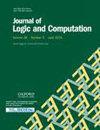理论应用于实践
IF 0.7
4区 数学
Q3 COMPUTER SCIENCE, THEORY & METHODS
引用次数: 0
摘要
本文通过作者和同事参与的三个IBM案例研究,将理论应用于实践。在第一个案例研究中,系统构建者(或实践者)启动交互。这种相互作用导致了以下问题。假设有一组对象,每个对象都有多个属性,并且每个对象的每个属性都分配了一个数值分数。在实值逻辑的精神中,有一个评分函数(如最小值或平均值),通过将评分函数应用于每个对象属性的分数来获得对象的排名,问题是找到最前面的$k$对象,同时最小化数据库访问次数。给出的算法在很强的意义上是最优的:不仅仅是在最坏的情况下或平均情况下,而是在每种情况下(直到一个常数因子)!尽管该算法只有8行(!),但包含该算法的论文获得了2014年Gödel奖,这是理论计算机科学论文的最高奖项。第二个案例研究中的互动是由理论家发起的,他们想为“数据交换”奠定基础,在这种交换中,数据从一种格式转换为另一种格式。尽管这个问题听起来平淡无奇,但由此产生的问题却令人着迷,这项工作使数据交换成为一个新的子领域,在每个主要的数据库会议上都有专门的会议。这项工作获得了2020年阿朗佐·丘奇奖,这是逻辑和计算研究的最高奖项。第三个案例研究是关于实值(或“模糊”)逻辑的,是IBM大型“逻辑神经网络”(LNN)项目的一部分。例如,“和”门的输入可以是区间[0,1]中的任意数字。LNN的系统建设者希望对实值逻辑有一个健全完备的公理化,这样他们就可以在给定其他真值的情况下尽可能地得到真值。这个最近的工作为一大类实值逻辑提供了一个健全和完整的公理化,包括最常见的实值逻辑。它还允许权重,其中一些子公式的重要性可能大于其他子公式。本文的目标是理论工作者和系统建设者,向他们展示合作的共同利益。这是通过上面提到的三个案例研究:两个由系统建设者发起,一个由理论家发起。对理论家的启示是通过实例说明如何将理论应用于实践,以及为什么将理论应用于实践可以产生更好的理论。制度建设者的道德是理论的价值,是参与的理论家的价值。这篇论文的文体很不正式。事实上,它是基于作者多次提出的关于“理论应用于实践”的演讲。本文章由计算机程序翻译,如有差异,请以英文原文为准。
Applying Theory to Practice
By making use of three IBM case studies involving the author and colleagues, this paper is about applying theory to practice. In the first case study, the system builders (or practitioners) initiated the interaction. This interaction led to the following problem. Assume that there is a set of objects, each with multiple attributes, and there is a numerical score assigned to each attribute of each object. In the spirit of real-valued logics, there is a scoring function (such as the min or the average), and a ranking of the objects is obtained by applying the scoring function to the scores of each object’s attributes The problem is to find the top $k$ objects, while minimizing the number of database accesses. An algorithm is given that is optimal in an extremely strong sense: not just in the worst case or the average case, but (up to a constant factor) in every case! Even though the algorithm is only 8 lines long (!), the paper containing the algorithm won the 2014 Gödel Prize, the top prize for a paper in theoretical computer science. The interaction in the second case study was initiated by theoreticians, who wanted to lay the foundations for ‘data exchange’, in which data is converted from one format to another. Although this problem may sound mundane, the issues that arise are fascinating, and this work made data exchange a new subfield, with special sessions in every major database conference. This work won the 2020 Alonzo Church Award, the highest prize for research in logic and computation. The third case study, specifically on real-valued (or ‘fuzzy’) logic, arose as part of a large ‘Logical Neural Nets’ (LNN) project at IBM. The inputs to, say, an ‘and’ gate could each be any numbers in the interval [0,1]. The system builders of LNN wanted a sound and complete axiomatization for real-valued logic, so that they could arrive at truth values given other truth values whenever possible. This recent work provides a sound and complete axiomatization for a large class of real-valued logics, including the most common ones. It also allows weights, where the importance of some subformulas can be greater than that of other subformulas. This paper is aimed at both theoreticians and system builders, to show them the mutual benefits of working together. This is via the three case studies mentioned above: two initiated by the system builders, and one by the theoreticians. The moral for the theoreticians is to show by example how to apply theory to practice, and why applying theory to practice can lead to better theory. The moral for the system builders is the value of theory, and the value of involving theoreticians. This paper is written in a very informal style. In fact, it is based closely on a talk on ‘Applying theory to practice’ that the author has presented a number of times.
求助全文
通过发布文献求助,成功后即可免费获取论文全文。
去求助
来源期刊

Journal of Logic and Computation
工程技术-计算机:理论方法
CiteScore
1.90
自引率
14.30%
发文量
82
审稿时长
6-12 weeks
期刊介绍:
Logic has found application in virtually all aspects of Information Technology, from software engineering and hardware to programming and artificial intelligence. Indeed, logic, artificial intelligence and theoretical computing are influencing each other to the extent that a new interdisciplinary area of Logic and Computation is emerging.
The Journal of Logic and Computation aims to promote the growth of logic and computing, including, among others, the following areas of interest: Logical Systems, such as classical and non-classical logic, constructive logic, categorical logic, modal logic, type theory, feasible maths.... Logical issues in logic programming, knowledge-based systems and automated reasoning; logical issues in knowledge representation, such as non-monotonic reasoning and systems of knowledge and belief; logics and semantics of programming; specification and verification of programs and systems; applications of logic in hardware and VLSI, natural language, concurrent computation, planning, and databases. The bulk of the content is technical scientific papers, although letters, reviews, and discussions, as well as relevant conference reviews, are included.
 求助内容:
求助内容: 应助结果提醒方式:
应助结果提醒方式:


